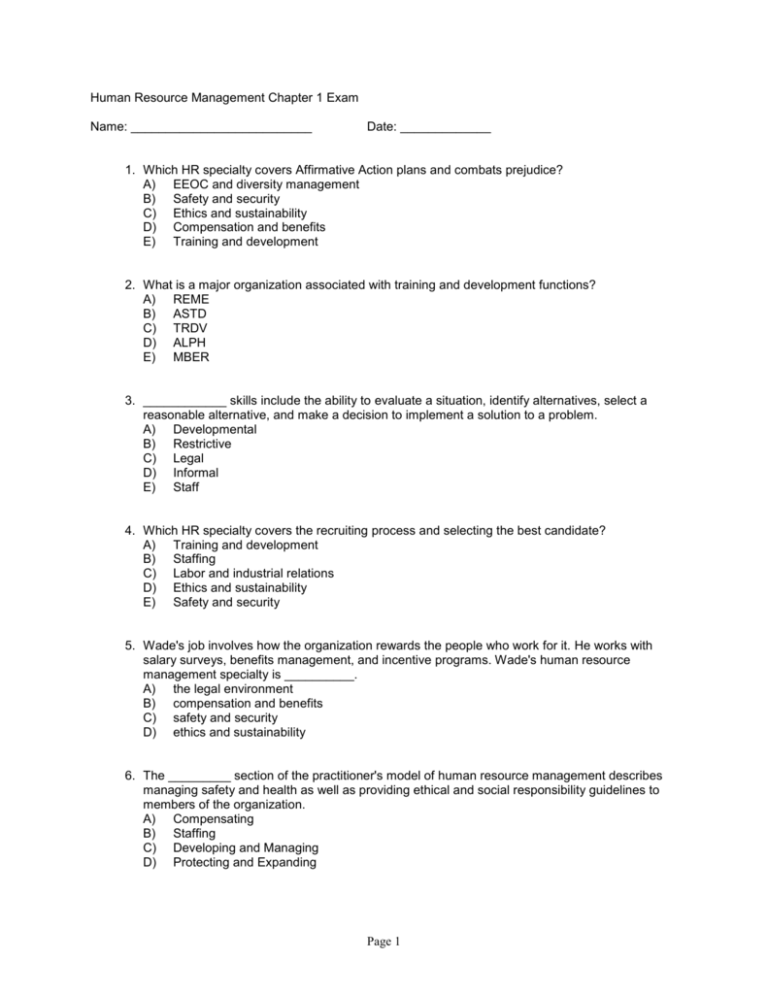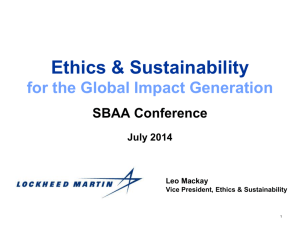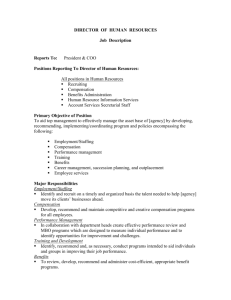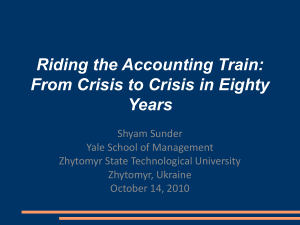HR Management Chapter 1 Exam Questions
advertisement

Human Resource Management Chapter 1 Exam Name: __________________________ Date: _____________ 1. Which HR specialty covers Affirmative Action plans and combats prejudice? A) EEOC and diversity management B) Safety and security C) Ethics and sustainability D) Compensation and benefits E) Training and development 2. What is a major organization associated with training and development functions? A) REME B) ASTD C) TRDV D) ALPH E) MBER 3. ____________ skills include the ability to evaluate a situation, identify alternatives, select a reasonable alternative, and make a decision to implement a solution to a problem. A) Developmental B) Restrictive C) Legal D) Informal E) Staff 4. Which HR specialty covers the recruiting process and selecting the best candidate? A) Training and development B) Staffing C) Labor and industrial relations D) Ethics and sustainability E) Safety and security 5. Wade's job involves how the organization rewards the people who work for it. He works with salary surveys, benefits management, and incentive programs. Wade's human resource management specialty is __________. A) the legal environment B) compensation and benefits C) safety and security D) ethics and sustainability 6. The _________ section of the practitioner's model of human resource management describes managing safety and health as well as providing ethical and social responsibility guidelines to members of the organization. A) Compensating B) Staffing C) Developing and Managing D) Protecting and Expanding Page 1 7. About 90 percent of the growth in the U.S. workforce between 2006 and 2016 is expected to come from which group? A) 15- to 24-year-olds B) 25- to 34-year-olds C) 35- to 44-year-olds D) 45- to 54-year-olds E) 55-year-olds and older 8. Sean wants to improve his workers' performance and productivity. To learn the best ways to do so, Sean could work to improve his skills with the ________ responsibilities of line management. A) safety and security B) appraisal and promotion C) leadership and motivation D) labor cost controls. 9. Samantha's job involves working on codes of ethics and making sure employees can report any violations of the code. Samantha's human resource management specialty is __________. A) training and development B) labor and industrial relations C) employee relations D) ethics and sustainability 10. Studies have shown that companies with high levels of _________ outperformed their peer companies in operating income, net income growth and earnings per share growth. A) Gross receipts B) Revenue C) Material and equipment D) Employee engagement E) Employee training 11. If a 21st century organization can manage its _______ better than its competitors, it has a much greater chance of being successful—more profitable and productive than its competitors—and of creating a competitive advantage. A) Equipment B) Facilities C) Human resources D) Consumables E) Environment 12. Who controls the processes within the organization—what the organization does? A) Staff management B) Line management C) Clerical workers D) Technicians E) Scientists Page 2 13. Zach is interested in measuring the amount of output that his organization gets per unit of input. Specifically, he would like to measure how much time each worker spends on each assignment. Zach is interested in measuring _______. A) revenue B) turnover C) productivity D) costs 14. As a line manager, Peter is often one of the first people to see a problem with the organization's manufacturing processes caused by lack of employee skill. Resolving the problem is a part of the ________ responsibilities of line management. A) legal considerations B) labor cost controls C) leadership and motivation D) training and development 15. Knowledge of EEO laws, computer skills, and training methodologies are all examples of which HR skill set? A) Technical skills B) Human Relations skills C) Conceptual skills D) Design skills E) Business skills 16. What is the largest association designed for HR managers? A) American Society for Personnel Administration B) Society for Human Resource Management C) American Human Resource Society D) International Human Management Organization E) Certified Human Resource Association 17. ______ is a function of getting the job done whenever and however it must be done. A) Productivity B) Efficiency C) Effectiveness D) Opportunity E) Preference 18. Absenteeism: A) Doesn't really cost the organization any money. B) Has indirect costs such as maintenance of insurance premiums. C) Costs the company double because another person must do the absent workers job. D) Has only direct costs associated with it. E) Rarely or never affects job satisfaction of other employees Page 3 19. _____ is an organization that is mainly devoted to compensation and performance management programs. A) National Compensation Society B) Employee Remuneration Organization C) WorldAtWork D) Compensation and Performance International E) Federated Human Resource Quartermasters 20. Getting the right people into the right jobs is an important. The _________ section of the practitioner's model of human resource management includes the items that will allow the organization to get its work done successfully over long periods of time. A) Protecting and Expanding B) Staffing C) Developing and Managing D) Compensating 21. Evan is putting together a proposal on the budget and strategic plan that describes how the human resources department will contribute to the profitability of the organization. Evan is using _______ skills to complete this task. A) technical B) human relations C) conceptual and design D) business 22. A ____________ is a division or department that generates monetary returns for the organization. A) Data processing center B) Collection center C) Cost center D) Revenue center 23. _____________ are an organization's most valuable asset. A) Materials B) People C) Facilities D) Economic Resources 24. Since 1980, what new era has emerged? A) Information age B) Industrial age C) Organization age D) Manufacturing age E) Production age 25. Forty years ago, HR managers were expected to be: A) “Paper pushers” B) Budget analysts C) Employee relations specialists D) Labor negotiators Page 4









